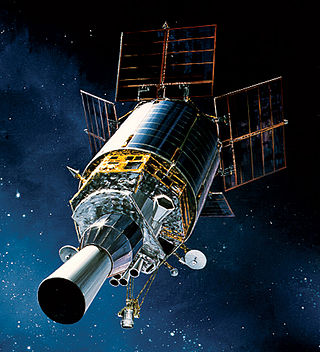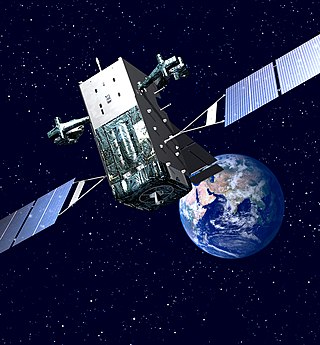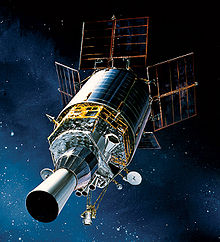
The Defense Support Program (DSP) is a program of the United States Space Force that operated the reconnaissance satellites which form the principal component of the Satellite Early Warning System used by the United States.

The Space-Based Infrared System (SBIRS) is a United States Space Force system intended to meet the United States' Department of Defense infrared space surveillance needs through the first two to three decades of the 21st century. The SBIRS program is designed to provide key capabilities in the areas of missile warning, missile defense, battlespace characterization and technical intelligence via satellites in geosynchronous Earth orbit (GEO), sensors hosted on satellites in highly elliptical orbit (HEO), and ground-based data processing and control.
Upravlyaemy Sputnik Kontinentalny or US-K is a series of Russian, previously Soviet, satellites used to detect missile launches as part of the Oko system. It consists of a constellation of satellites, usually in molniya orbits, designated under the Kosmos system. The satellites are built by the company NPO Lavochkin and are launched on Molniya-M rockets. Oko can be directly translated as the Russian word for eye. As of June 2014, only two of the eight satellites in orbit were still functional, rendering the system inoperable.

The Missile Defense Alarm System, or MIDAS, was a United States Air Force Air Defense Command system of 12 early-warning satellites that provided limited notice of Soviet intercontinental ballistic missile launches between 1960 and 1966. Originally intended to serve as a complete early-warning system working in conjunction with the Ballistic Missile Early Warning System, cost and reliability concerns limited the project to a research and development role. Three of the system's 12 launches ended in failure, and the remaining nine satellites provided crude infrared early-warning coverage of the Soviet Union until the project was replaced by the Defense Support Program. MiDAS represented one element of the United States's first generation of reconnaissance satellites that also included the Corona and SAMOS series. Though MIDAS failed in its primary role as a system of infrared early-warning satellites, it pioneered the technologies needed in successor systems.
US-KMO, is a series of Russian, previously Soviet, satellites which are used to identify ballistic missile launches. They provide early warning of missile attack and give information for the Moscow A-135 anti-ballistic missile system. They were run by the Russian Space Forces and it was succeeded by the Aerospace Defence Forces.
Upravlyaemy Sputnik Kontinentalny Statsionarny, or US-KS, also known as Oko-S, was a series of Soviet, and later Russian, missile detection satellites launched as part of the Oko programme. US-KS was a derivative of the US-K satellite, optimised for operations in geosynchronous orbit. Seven were launched between 1975 and 1997, when launches ended in favour of the modernised US-KMO. US-KS had the GRAU index 74Kh6. As of December 2015, the entire Oko programme is being replaced by the new EKS system.
USA-230, also known as SBIRS GEO-1, is a United States military satellite and part of the Space-Based Infrared System.
Oko is a Russian missile defence early warning programme consisting of satellites in Molniya and geosynchronous orbits. Oko satellites are used to identify launches of ballistic missiles by detection of their engines' exhaust plume in infrared light, and complement other early warning facilities such as Voronezh, Daryal and Dnepr radars. The information provided by these sensors can be used for the A-135 anti-ballistic missile system which defends Moscow. The satellites are run by the Russian Aerospace Forces, and previously the Russian Aerospace Defence Forces and Russian Space Forces. Since November 2015, it is being replaced by the new EKS system.
Kosmos 2345 is a Russian US-KS missile early warning satellite which was launched in 1997 as part of the Russian Space Forces' Oko programme. The satellite is designed to identify missile launches using optical telescopes and infrared sensors.
Kosmos 1894 is a Soviet US-KS missile early warning satellite which was launched in 1987 as part of the Oko programme. The satellite is designed to identify missile launches using optical telescopes and infrared sensors.
Kosmos 775 is a Soviet US-KS missile early warning satellite which was launched in 1975 as part of the Oko programme. The satellite is designed to identify missile launches using optical telescopes and infrared sensors.
EKSKupol is a developing programme of Russian early warning satellites as a replacement for the US-KMO and US-K satellites of the Oko programme. The satellites are designed to identify any possible future ballistic missile launches, from outer space, and complement early warning radars such as the Voronezh. This gives advance notice of a nuclear attack and would provide information to the A-135 missile defence system which protects Moscow, as well as other Russian missile defense and counterattack resources. Six satellites are planned to be initially orbited. The first of these was launched on 17 November 2015 and as of November 2022, all six of them are in service.
Serpukhov-15 is a military townlet near Kurilovo in Kaluga Oblast which is the location of the western control centre for Russia's Oko satellites. These give early warning of ballistic missile launches, mainly from the continental United States. The site is part of the Main Centre for Missile Attack Warning and information from here is processed at the Russian Aerospace Defence Forces centre in Solnechnogorsk and could be used, together with early warning radar such as the Voronezh, for launch on warning of the A-135 anti-ballistic missile system. A similar facility is located at Pivan-1 in the Russian Far East.
Pivan-1 is a military townlet near Komsomolsk-na-Amur in Khabarovsk Krai in the Russian Far East which is the location of the eastern control centre for Russia's Oko satellites. These give early warning of ballistic missile launches, mainly from the continental United States. The site is part of the Main Centre for Missile Attack Warning and information from here is processed at the Russian Aerospace Defence Forces centre in Solnechnogorsk and could be used, together with early warning radar such as the Voronezh, for launch on warning or the A-135 anti-ballistic missile system. A similar facility is located at Serpukhov-15 near Moscow.

USA-241, also known as SBIRS GEO-2, is a United States military satellite and part of the Space-Based Infrared System.
The USP, for Universal Space Platform, also known as Viktoria (Виктория), is a highly flexible satellite bus designed and manufactured by RSC Energia. It is called universal because it has been designed to be operated from LEO to GEO. It is a three axis stabilized platform with electric propulsion for station keeping, but chemical propellant is offered as an option. The bus can offer up to 3000 W of power and a payload capacity up to 1,000 kg (2,200 lb) for Low Earth orbit or HEO an up to 300 kg (660 lb) for geostationary orbit.

USA-273, also known as SBIRS GEO-3, is a United States military satellite and part of the Space-Based Infrared System (SBIRS).

USA-282, also known as SBIRS GEO-4, is a United States military satellite and part of the Space-Based Infrared System.
Tongxin Jishu Shiyan is a Chinese military satellite program operating in geostationary orbit (GEO). TJS satellites are manufactured by the Shanghai Academy of Spaceflight Technology (SAST) and launched from Xichang Satellite Launch Center (XSLC) in China's southern Sichuan Province. TJS is likely the cover name for multiple geostationary military satellite programs and should not be confused with the similarly named Shiyan satellite program.








